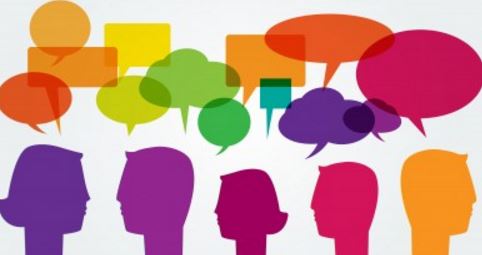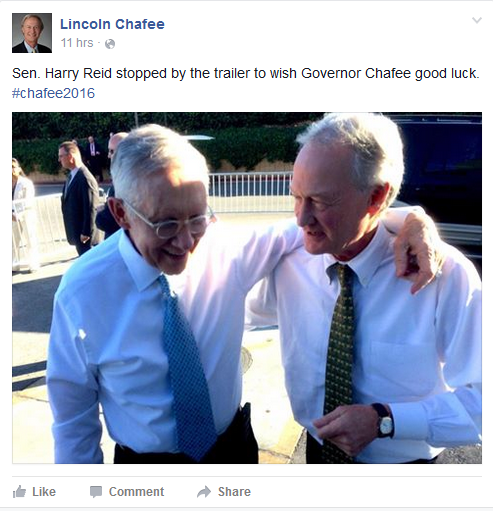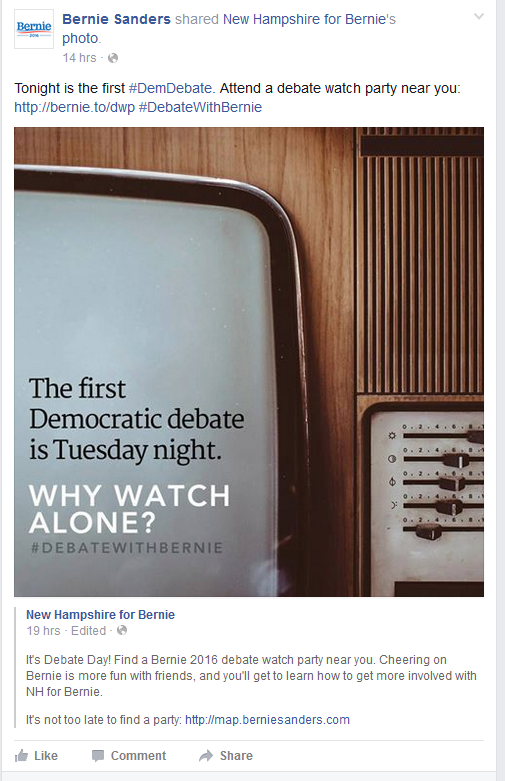Analyzing the social media streams of the presidential candidates tell us a lot about their savviness for running a contemporary campaign. It also tells us the likelihood of their continuing the long road to the nomination.
The recently launched Illuminating 2016 project, which involves faculty and students of the School of Information Studies (iSchool), collects and analyzes the Twitter and Facebook accounts of the presidential candidates. (Illuminating 2016 is a joint project of The Center for Computational and Data Sciences (CCDS) and the Behavior, Information Technology and Society Lab (BITS) there.)
We recently did analysis of candidates’ social media activity based on their Twitter and Facebook account information on the day of the first Democratic Debate.
What Debates Do
Presidential debates are major media events. They can help unknown candidates get their names, personalities, and policies before the public. Debates drive news coverage and focus the public’s attention on the election–even though it’s still more than a year away. That news coverage and attention, in turn, stimulates the public to learn more about the candidates, including looking them up on Facebook and Twitter.
Looking at social media on the day of the first Democratic debate, our project’s analysis suggests that some candidates may not have a clear path to success with the public.
Our analysis shows that Lincoln Chafee and Jim Webb are polling in the single digits nationally and regionally, and their efforts on social media corroborate their weak status.
We’ve assessed that they don’t have a large following on social media, and also that they aren’t using social media to its fullest potential to increase their campaign support.
We can see just by looking at their social media efforts on Debate Day that the lesser-known candidates–Martin O’Malley, Jim Webb, and Lincoln Chafee–have relatively tiny amounts of Facebook and Twitter followers—compared to the numbers that their dominating rivals, Hillary Clinton and Bernie Sanders, have.
Clinton Tops on Twitter
Indeed, Clinton completely overshadows her rivals in terms of her followers on Twitter. She also has more than 1.5 million Facebook page likes.
Interestingly, while she been active and visible on Facebook since her last presidential run in 2008, Sanders, a relative newcomer, actually has more Facebook page likes, suggesting energy and excitement for his candidacy.
Debate Differences
When we examine candidates’ Debate Day activity, we see a few noteworthy differences.
Clinton, Sanders, and O’Malley generated relatively the same number of tweets. They were active and engaged, but not overwhelmingly so.
By contrast, Jim Webb tweeted over 90 times before and during the debate. Chafee tweeted less than 20 times that day. We might say that Webb is trying too hard and Chafee is not trying hard enough to communicate with followers.
Message Types
Perhaps the most telling analysis looks at the types of messages the campaigns made on debate day. We analyzed campaign messages using an algorithm we have built to categorize their messages.
What we see is that Hillary Clinton and Jim Webb engage in the most strategic messaging. These messages advance their positions on the issues, construct their image, and attack their opponents. These are the types of messages that typically are associated with TV ads and stump speeches.
Clinton, for example, posted a message on Facebook that reinforced her during-debate statement about gun violence. Sanders did as much strategic messaging as he did calling on people to act. This type of message urges supporters to do something: contribute, attend an event, retweet a message, watch a video.
O’Malley did more work urging people to action than he did in constructing his image or advancing his policy positions. Webb did the opposite –presenting messages that were much more about image and position construction.
Lincoln Chafee didn’t ask people to act and barely worked to advance his message. Instead, he produced neutral information messages, such as announcing that he’s debating. In one Facebook message, he is shown with Harry Reid, Senate Minority Leader. This is an old-school mode of campaigning that assumes followers know and care that Chafee and Reid are pals.
The Chafee campaign isn’t capitalizing effectively on the media event of the debate, using it to increase supporters and drive more money into campaign coffers.
By contrast, Bernie Sanders’ Facebook page encouraged people to participate in a debate-watch party, and included a hyperlink to his website to find house parties, to sign-up to receive updates from the campaign, and to contribute money.
Taking Temperatures
It’s possible to use social media to take the temperature of the campaigns. It provides another measuring stick, like public opinion polls and campaign contributions.
Looking at the Democratic candidates’ social media activity, it’s clear that Webb and Chafee have a long road ahead.
Do you have a comment about the use of social media in election campaigns? Can you offer an observation about the use of social media during the Democratic Debate? Please add your comments to the conversation, and leave them here!




